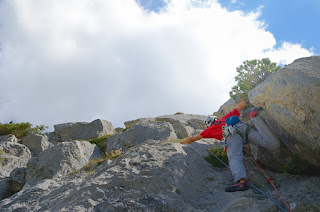One of the jewels in the northern Alpine limestone mountains is the Watzmann near Berchtesgaden not far away from the Austrian order and Salzburg. On the 7/8th of September 2018, Marco, Matthias and I decided to do the Watzmann traverse, a technically easy but long, classic mountaineering tour with some via ferrata sections. Marco and Matthias and I are childhood friends and we all did triathlons together.
I did the first peak of the Watzmann range in May 2016, just after my arrival in Munich. On the right is the Hocheck, on the left the Watzmann wife and in-between the Watzmann kids (May 2016 photo).
Here, a view from the Hocheck to the Watzmann alpine hut and the glen below (another May 2016 photo).
The Watzmann is 2713 m and the Wimbach car park so a 2000 m+ ascent. For that reason the Watzmann alpine hut is popular but you need to book months in advance. So we had booked from the 8th-9th of September and the forecast was unstable so we had countless "go" or "no go" e-mails. In the end the weather looked bad for Friday but good for Saturday. I arrived at 3 pm and did a speedy ascent to the hut in murky weather with only a few drops of rain.
The hut was not full. We had food & beer and retired just after 9 pm hoping that the walking & beer would make us sleep at least for a bid (and not send us to the toilet!). Alpine hut bunkbeds are not my favourite but a means to an end. I slept but woke up at 2 am and waited for dawn.
The weather looked good and so we got up at 6 am, had breakfast and left at 7.15 am. Here is the sign of the hut.
And here we start.
The first bit is the ascent to the Hocheck at 2651 m which is the start of the ridge. Here is Marco glad to start the fun bit.
Most of the ridge is exposed via ferrata-style scrambling interspersed with walking on bands.
Here is Matthias on a large slab...
... and here Marco scrambles up a corner.
We soon arrived at the Mittelspitze (2713 m) which is the highest summit of the ridge.
During the whole ridge traverse the Western side was free of clouds but the Eastern side was covered. This is a pity because the Eastern side is a 2000 m-high face that rises all the way from the Koenigssee (King's loch) to the ridge. It unfortunately has a lot of lose rock, is not too steep and has a couple of easier routes. Here is Marco continuing towards the Southern end of the ridge.
A few exposed bits without rope so being steady and careful is key to avoid the "ride royal".
Here, is a fin bit scrambling down a large pillar which is secured with iron cables.
More scrambling...
... and an exposed band leading back up to the ridge.
On the Western side we could at times see all the way down to the glen which is between 1500-2000 m below.
Just before the end the ridge narrows to a knife edge for some exposed scambling...
... before an easier ascent to the Suedspitze (2712 m). Here is team MMH.
And then the endless descent from 2700 m to 600 m altitude. Add to that plenty of scrambling and descending on lose rock with only a wee bit of scree surfing.
Here, we have left the upper scrambly bit and descent on slippery, lose rock and gravel.
At around 1800 m of altitude the landscape becomes greener and there is a small screen with fresh, clear mountain water.
The walking is rarely straight forward. Here a sandy chute with an ion chain.
Things only become benign when you reach the Wimbachgries at 1400 m of altitude, so one Ben Nevis down from the top. It is a glen filled with limestone gravel from the mountains that surround it. I was greeted by two chamois.
The Wimbachgries is a Lord of the Rings landscape and the paty is easy-to-walk gravel.
Here is Matthias with the Watzmann and descent line behind him.
Here is Marco descending to the Wimbachgrieshuette at 1327 m, roughly the altitude of the Ben.
Marco and Matthias stayed there but I walked out another 2 h to reach the Wimbach car park. Here, a last zoom photo of the Suedspitze.
Logistics: The best time is from July (earlier there is too much snow) to October with a stable no thunderstorm forcast. Being nearly 3000 m high means that the temperatures on the ridge will almost be 15 degrees less than in the glen. The Watzmann ridge is like the Aonach Eagach on steroids so be fit especially if you plan a glen-to-glen ascent. Being fit means Marathon fitness plus being able to ascent and descent 2300 m in a day. You have two options either book the Watzmannhaus ideally 6 months in advance or do the glen-to-glen round. If you climb VS or above, you probably do not need a via ferrata harness and that will speed you up. Ideally avoid weekends in season as the ridge will be crowded.
HW






















































